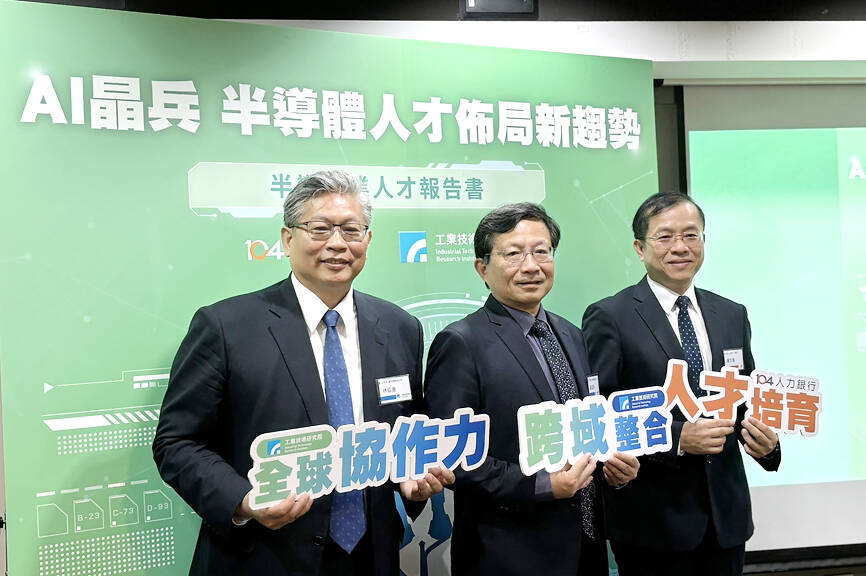Taiwan’s semiconductor industry faced a shortage of 34,000 workers as of May, a report released by 104 Job Bank (104人力銀行) and the government-backed Industrial Technology Research Institute (ITRI, 工研院) showed yesterday.
The shortage is attributed to the industry’s ongoing expansion, driven by increased investment in advanced manufacturing processes, the 2025 Semiconductor Industry Talent Report said.
The three main job categories in demand were “production/quality control/environmental safety,” “research and development,” and “operations/technical support and maintenance,” the report said.

Photo: CNA
Job openings for production, quality control and environmental safety grew from 5,600 in October 2023 to about 10,000 in May, while demand in research and development rose from 6,000 positions in 2023 to 9,316 in May, it said.
Job openings in operations/technical support and maintenance surged 67 percent, from 4,300 in October 2023 to 7,240 in May.
The increase reflects rising demand for equipment operators and maintenance personnel, driven by the expansion of advanced manufacturing processes and packaging production lines, it said.
Last year, Taiwan accounted for 68.8 percent of the global foundry market and led the world in integrated circuit (IC) packaging and testing, holding nearly 50 percent of the market, said Jeff Lin (林昭憲), general director of the ITRI’s Industry, Science and Technology International Strategy Center.
The country is also a key production hub for chips at 7 nanometers and below, and produces up to 83 percent of the world’s artificial intelligence chips, Lin said.
From 2010 to last year, the output value of the nation’s IC industry tripled, while the number of newborns declined by about 20 percent, raising concerns over a potential talent gap.
Recruiting talent for operations/technical support and maintenance roles has proven especially challenging due to the need for shift work and an emphasis on hands-on, on-site skills, the report said.
The report also examined the sector’s salary structure, showing that among non-managerial positions, analogue IC design engineers earned the highest median annual salary at NT$1.78 million (US$60,292), followed by digital IC design engineers with a median salary of NT$1.57 million, it added.

Shiina Ito has had fewer Chinese customers at her Tokyo jewelry shop since Beijing issued a travel warning in the wake of a diplomatic spat, but she said she was not concerned. A souring of Tokyo-Beijing relations this month, following remarks by Japanese Prime Minister Sanae Takaichi about Taiwan, has fueled concerns about the impact on the ritzy boutiques, noodle joints and hotels where holidaymakers spend their cash. However, businesses in Tokyo largely shrugged off any anxiety. “Since there are fewer Chinese customers, it’s become a bit easier for Japanese shoppers to visit, so our sales haven’t really dropped,” Ito

The number of Taiwanese working in the US rose to a record high of 137,000 last year, driven largely by Taiwan Semiconductor Manufacturing Co’s (TSMC, 台積電) rapid overseas expansion, according to government data released yesterday. A total of 666,000 Taiwanese nationals were employed abroad last year, an increase of 45,000 from 2023 and the highest level since the COVID-19 pandemic, data from the Directorate-General of Budget, Accounting and Statistics (DGBAS) showed. Overseas employment had steadily increased between 2009 and 2019, peaking at 739,000, before plunging to 319,000 in 2021 amid US-China trade tensions, global supply chain shifts, reshoring by Taiwanese companies and

Taiwan Semiconductor Manufacturing Co (TSMC) Chairman C.C. Wei (魏哲家) and the company’s former chairman, Mark Liu (劉德音), both received the Robert N. Noyce Award -- the semiconductor industry’s highest honor -- in San Jose, California, on Thursday (local time). Speaking at the award event, Liu, who retired last year, expressed gratitude to his wife, his dissertation advisor at the University of California, Berkeley, his supervisors at AT&T Bell Laboratories -- where he worked on optical fiber communication systems before joining TSMC, TSMC partners, and industry colleagues. Liu said that working alongside TSMC

TECHNOLOGY DAY: The Taiwanese firm is also setting up a joint venture with Alphabet Inc on robots and plans to establish a firm in Japan to produce Model A EVs Manufacturing giant Hon Hai Precision Industry Co (鴻海精密) yesterday announced a collaboration with ChatGPT developer OpenAI to build next-generation artificial intelligence (AI) infrastructure and strengthen its local supply chain in the US to accelerate the deployment of advanced AI systems. Building such an infrastructure in the US is crucial for strengthening local supply chains and supporting the US in maintaining its leading position in the AI domain, Hon Hai said in a statement. Through the collaboration, OpenAI would share its insights into emerging hardware needs in the AI industry with Hon Hai to support the company’s design and development work, as well